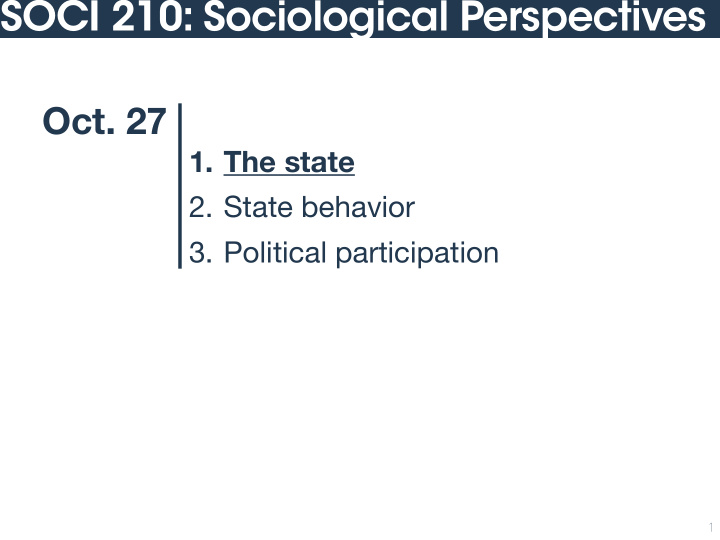



SOCI 210: Sociological Perspectives Oct. 27 1. The state 2. State behavior 3. Political participation 1
Administrative Mid-term peer review exercise due this week ⦙ Every student should have received an email with a Microsoft Excel attachment ⦙ Please enter a number (0–10) into each of the yellow cells marked with an ‘X’ and save the file ⦙ Upload to MyCourses by 8pm on Friday, Oct 30 ⦙ Results will be aggregated and sent to group members ( no individual scores will be shared ) ⦙ This round will not a ff ect final marks for the class ⦙ Completion is required , and will contribute an automatic 2.5% to your final mark for the class 2
The State 3
The state What is ‘ the ’ state? ⦙ The existence of a state is usually taken for granted ⦙ The state is a powerful Law enforcement; incarceration; military deployment ⦙ The state has final authority in most matters ⦙ The state is distinct from government Government is the institution that organizes state behavior 4
The state Max Weber on the state ⦙ State is compulsory ⦙ State represented by a centralized government ⦙ State maintains a monopoly on the legitimate use of force ⦙ State has jurisdiction within a certain territory E.g. Canada and Wet’suwet’en ⦙ Monopoly No such thing as multiple states ⦙ Territory States’ reach is geographic ⦙ Compulsory No “opting out” RCMP helicopter lands at gates of ⦙ Government Wet’suwet’en Unist’ot’en Village Omits social organization without formal government institution ⦙ Legitimacy … 5
Statelessness 6
Images of statelessness All against all 2 Natural law 3 “State of nature” Three visions of human society without a state 1 Social institutions 7
Images of statelessness All against all 2 Natural law 3 “State of nature” Three visions of human society without a state 1 Social institutions Thomas Hobbes, Leviathan (1651) ⦙ Hypothetical (rhetorical) human history ⦙ State of nature is chaos ⦙ Interpersonal violence only resolution to conflict— ‘ war of all against all ’ ⦙ “continual fear and danger of violent death, and the life of man, solitary, poor, nasty, brutish, and short.” 8
Images of statelessness All against all 2 Natural law 3 “State of nature” Three visions of human society without a state 1 Social institutions John Locke, Two Treatises of Government (1689) ⦙ Refers to empirical “states of nature” in human history ⦙ Human reason exists without formal state ⦙ Mutual respect for life, liberty, and property is rational and natural ( natural law ) ⦙ State of nature not chaotic— governance emerges naturally 9
Images of statelessness All against all 2 Natural law 3 “State of nature” Three visions of human society without a state 1 Social institutions Social anarchism (e.g. Peter Kropotkin) ⦙ Proposed as ideal state of society—reject the idea of a natural, primordial “state of nature” ⦙ Human society can organize itself without a formal state ⦙ State is inherently problematic ⦙ Instead: voluntary institutions, mutual aid, norms of collaboration 10
Images of statelessness The Road Warrior (a.k.a. Mad Max 2) (1981) 11
Images of statelessness Dominance by strongest All against all Hobbes No lasting social order All humans equal Subject to universal, natural law Locke Order from rational ideals of justice Social structures exist without state Social Communities enforce norms anarchist Order from voluntary cooperation 12
Image credit Photo by Roberto The Road Warrior (1981) Catarinicchia o ffi cial poster Photo by Michael Still from Toledano The Road Warrior (1981) The frontispiece of the Still from book Leviathan by Thomas The Road Warrior (1981) Hobbes; engraving by Abraham Bosse Photo by Luke Stackpoole Still from The Road Warrior (1981) Bobby Seale Checks Food Bags Photograph by Howard Erker 13
Recommend
More recommend